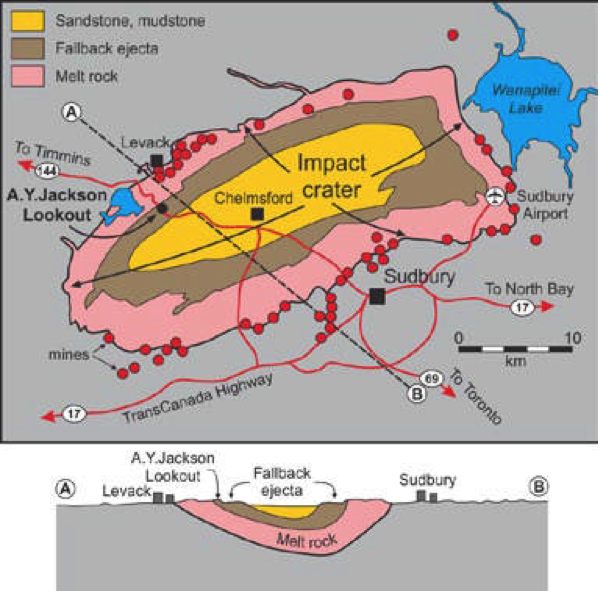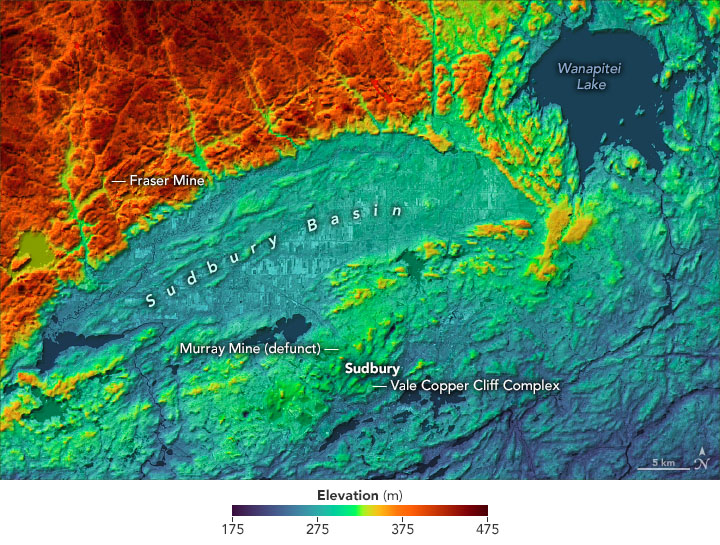
SUDBURY IMPACT STRUCTURE Crater Explorer
Within Canada is the 2nd largest impact crater on the planet. I am not referring to the 100 kilometer wide Manicouagan Reservoir Crater, but instead somethin.

Pingualuit impact crater Artofit
The Onaping formation of the Sudbury structure (Canada): an example of allochthonous impact breccias (extended abstract). Tectonophysics, v. 216, pp. 227-234. 1992. Avermann, M. E., Sudbury project (University fo Munster-Ontario Geological Survey): (6) Origin of the polymict, allochthonous breccias of the Onaping formation (abstract).

This lake in Canada was formed by a meteorite over a million years ago
The city of Sudbury is located to the south-east of the SIC. Formation of the original crater The Sudbury Structure is situated within a unique Geotectonic setting in northeastern Ontario, being sandwiched between: the Archean-age (>2.5 billion-year-old) Superior Geologic or Structural Province, situated to west and north of the structure, and;

Canada/Sudbury Crater ! YouTube
Space Astronomy Comets A Comet Did It! Mystery of Giant Crater Solved News By Tia Ghose published 18 November 2014 The Sudbury Basin, the world's second-largest impact crater, as seen from.

Sudbury Basin Alchetron, The Free Social Encyclopedia
The Sudbury structure is a large (D ~200 km, 1850 Ma), deformed and eroded impact crater, whose central region was occupied by melt. An eight-year multidisciplinary study by Stoffler et al. (1994) concluded that the impact excavated deep into the crust, almost to the mantle (~30 km), before collapse and rebound.

7 Largest Craters in the World Travel Trivia
Definition The Sudbury impact structure, Canada, represents the eroded remains of an impact basin originally 150-200 km in diameter which formed ~1.85 Ga ago. It contains world-class ore deposits, associated with the Sudbury Igneous Complex, which represents the differentiated original impact melt sheet.

Meteorite Impact Lakehead Region Conservation Authority
(Jenifer Norwell/CBC) It's been long believed the Sudbury Basin was shaped by an asteroid that hit the region more than a billion years ago, but a Laurentian University researcher now says it.

SUDBURY IMPACT STRUCTURE Crater Explorer
SHATTERCONES This 18 cm shattercone was found just outside of the Sudbury Igneous Complex (SIC). The discovery of shatter cones confirmed that a large meteorite impact caused the formation of the Sudbury Igneous Complex (Gibson, Spray 1998). After 1.85 Billion years the striations on the shatter cone illustrated above are still recognizable.

SUDBURY IMPACT STRUCTURE Crater Explorer
The Sudbury Basin ( / ˈsʌdbəri / ), also known as Sudbury Structure or the Sudbury Nickel Irruptive, is a major geological structure in Ontario, Canada. It is the third-largest known impact crater or astrobleme on Earth, as well as one of the oldest. [1] The crater was formed 1.849 billion years ago in the Paleoproterozoic era. [2]

10 Most Impressive Impact Craters On Earth Canada road trip, Canadian
The Sudbury impact crater/structure from GOZooM over the centre of the structure looking north-east. Lake Wanapetei is top left in the image and Kelly Lake right centre. The flatness of the internal crater structure is obvious. This image was taken from the north of the structure while flying over the Superior province country rock.

SUDBURY IMPACT STRUCTURE Crater Explorer
The Operational Land Imager (OLI) on Landsat 8 acquired this image of Sudbury Basin in southeastern Ontario on September 11, 2020. Notice the many mines located around the basin, particularly along the rim.

Lake Wanapitei, an impact crater site right on the edge of the Sudbury
The present-day remnant of the Sudbury Meteorite Crater is composed by a surrounding brecciated footwall rocks of both the Superior and southern Structural Geologic Provinces extending up to 100 km away from the position of the Sudbury Igneous Complex (SIC), the SIC itself and rocks of the Whitewater Group (melt breccia, suevite, and reworked suevite) in the Sudbury Basin within the SIC.

Clues to origins of life may be found in Sudbury, Ont. crater Sudbury
First, the Sudbury date pattern can be correlated with fractures in the central peak crater Haldane (36 km in diameter). This comparison indicates an initial Sudbury diameter of between 100 and 140 km but requires loss of a central peak complex for which there is little evidence.

Sudbury Impact Structure
The Sudbury Basin ( / ˈsʌdbəri / ), also known as Sudbury Structure or the Sudbury Nickel Irruptive, is a major geological structure in Ontario, Canada. It is the third-largest known impact crater or astrobleme on Earth, as well as one of the oldest. The crater was formed 1.849 billion years ago in the Paleoproterozoic era.
_Ontario.jpg/765px-Shattercone%2C_Sudbury_Impact_Structure_(1.85_Ga)_Ontario.jpg)
FileShattercone, Sudbury Impact Structure (1.85 Ga) Ontario.jpg
The present‐day impact structure is the largest and best exposed geological transect across a crater from the damaged crust below, through the melt sheet and impact breccias above, to post‐impact sediments (Ames et al., 2008).It is expressed as a large body of brecciated footwall rocks cut by radial and concentric offset dikes (locally referred to as quartz diorite or QD; Grant and Bite.

GC1E7PB Sudbury Astrobleme! (Earthcache) in Ontario, Canada created by
Abstract— Orogenic deformation, both preceding and following the impact event at Sudbury, strongly hinders a straightforward assessment of impact‐induced geological processes that generated the Sudbury impact structure. Central to understanding these processes is the state of strain of the Sudbury Igneous Complex, the solidified impact melt sheet, its underlying target rocks, overlying.